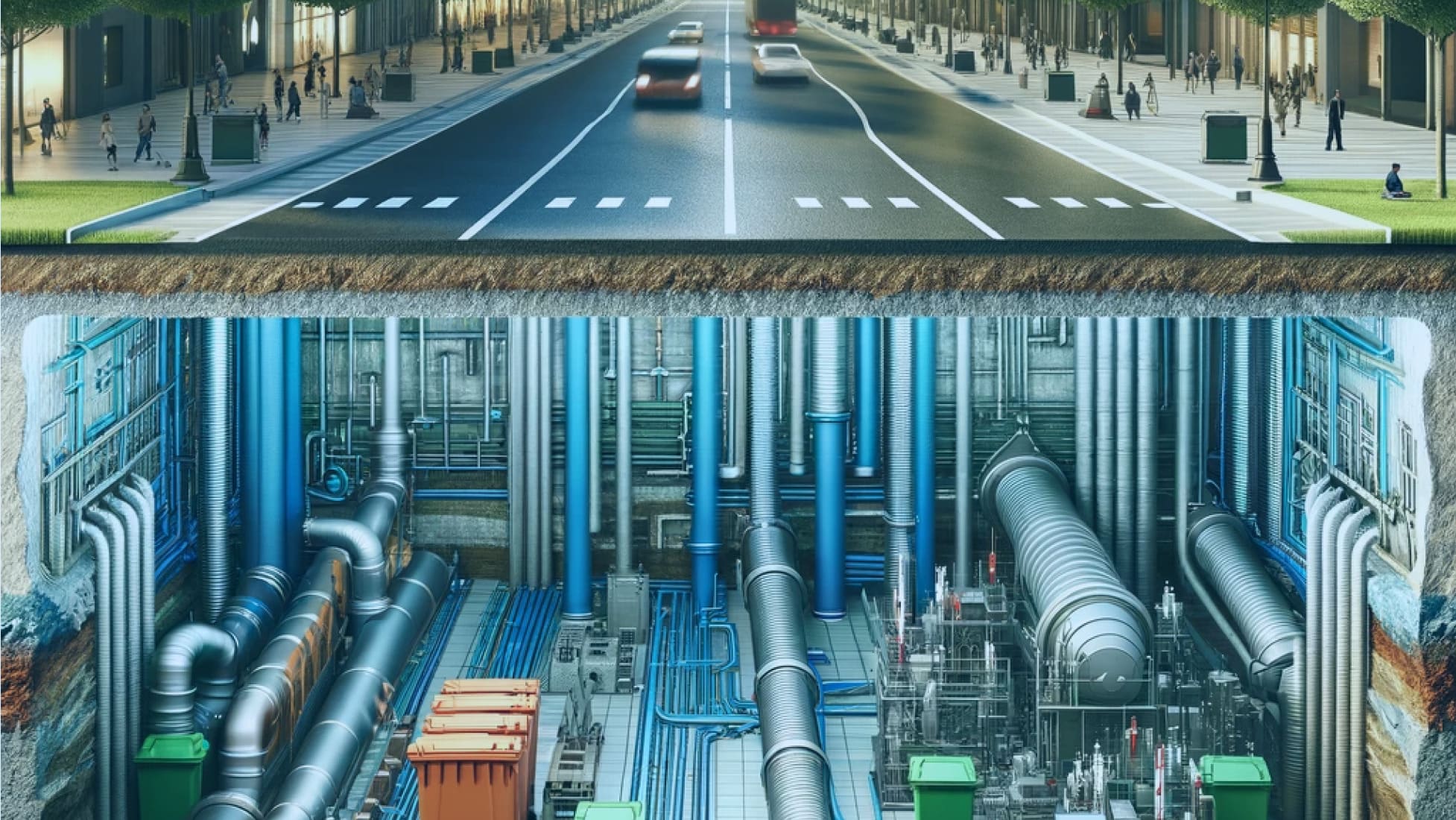Waste management has undergone a remarkable transformation over the years, evolving from simple disposal methods to sophisticated and sustainable systems. Among these, Underground Waste Collection Systems stand out as a modern solution, offering a blend of efficiency, aesthetics, and environmental friendliness. In this article, we delve into the world of underground waste collection, exploring its mechanisms, benefits, and the future it holds for urban environments.
What is Underground Waste Collection?
Underground waste collection is an innovative approach to managing and disposing of waste in urban environments. Unlike traditional methods that rely on surface-level bins and regular collection by waste trucks, this system utilizes a network of subterranean pipes and containers. Here’s an overview:
Functioning
- Waste Deposit: Residents and businesses dispose of their waste in designated inlets or bins located at street level.
- Transportation: The waste is then transported from these inlets to a central collection point via underground conduits. This transportation can be facilitated by gravity or pneumatic systems (using air pressure).
- Collection: At the central point, waste is compacted, stored, and eventually removed for further processing, recycling, or disposal.
Key Features
- Reduced Surface Impact: The system minimizes the need for multiple waste bins on streets, thereby reducing visual clutter and odor.
- Improved Efficiency: Automated collection processes reduce the frequency and cost of waste pickup and can lead to more efficient waste management.
- Environmental Benefits: By reducing the number of garbage trucks needed, underground waste systems can lower greenhouse gas emissions and traffic congestion.
- Hygiene and Safety: These systems can improve overall cleanliness and hygiene in urban areas and reduce the risk of accidents associated with waste collection.
Applications
Underground waste collection is particularly suitable for densely populated urban areas where space is limited and environmental concerns are paramount. It is increasingly being adopted in cities worldwide, both in new developments and as retrofits in existing urban areas.
What is Underground Waste Collection?
Environmental Benefits
Underground waste collection systems offer significant environmental advantages. By reducing surface-level waste, these systems minimize the impact on local ecosystems and help maintain cleaner urban spaces. Furthermore, they play a crucial role in reducing greenhouse gas emissions associated with traditional waste collection methods.
Urban Aesthetics and Space Saving
One of the most apparent benefits of underground waste systems is the enhancement of urban aesthetics. By removing unsightly bins and containers from streets, these systems free up valuable space, contributing to more pleasant and less cluttered cityscapes.
Hygiene and Public Health Considerations
Underground systems also score high on hygiene and public health. By containing waste below the surface, they effectively reduce odors, pests, and the spread of disease, contributing to healthier urban environments.
How Does Underground Waste Collection Work?
The Basic Mechanism
The fundamental principle of underground waste collection involves collecting waste in subterranean containers or through pneumatic tubes. These systems are designed for easy access, efficient collection, and minimal disruption to the urban landscape.
Types of Underground Systems: Pneumatic vs. Container-Based
There are primarily two types of underground waste systems: pneumatic and container-based. Pneumatic systems transport waste through underground tubes to a central collection point, while container-based systems use large underground bins that are periodically emptied. Each type has its unique advantages and is suitable for different urban contexts.
Design and Installation Considerations
Site Analysis and Planning
Implementing an underground waste system requires careful site analysis and planning. Factors such as soil type, urban infrastructure, and the existing waste management framework play a critical role in determining the feasibility and design of the system.
Technical Requirements and Infrastructure
The technical requirements for installing an underground system include considerations for space, load capacity, access points, and integration with existing waste management practices. Additionally, the infrastructure must be designed to withstand environmental factors and long-term use.
Aesthetic and Urban Design Integration
Integrating underground waste systems into the urban design is crucial for maintaining the aesthetic appeal of the cityscape. This involves designing discreet and accessible waste drop-off points that blend seamlessly with the surrounding environment.
Operational Aspects of Underground Systems
Collection and Transportation Process
The operational efficiency of underground waste systems is a key advantage. These systems enable more streamlined and less disruptive collection processes, reducing the frequency and visibility of waste collection activities.
Maintenance and Upkeep
Regular maintenance and upkeep are essential for the smooth operation of underground systems. This includes routine inspections, cleaning, and repairs to ensure the longevity and efficiency of the system.
Safety Measures and Protocols
Safety is paramount in the operation of underground waste systems. This involves adhering to strict protocols for handling waste, ensuring secure access points, and implementing emergency procedures in case of malfunctions or accidents.
Technological Advancements in Underground Waste Collection
The integration of technology in UWCS is a game-changer. Smart sensors can monitor waste levels, optimizing collection schedules. Future innovations might include more advanced sorting mechanisms and integration with city-wide management systems for even greater efficiency.
Installation Process of Underground Waste Systems
Installing an underground waste system is a complex process that requires careful planning. It involves extensive groundwork and coordination with urban planning entities. The challenges include navigating underground utilities and ensuring minimal disruption to city life.
Cost Analysis of Underground Waste Collection
While the initial investment in underground waste systems can be substantial, the long-term savings are significant. These systems reduce the need for frequent waste pickups, lower labor costs, and have longer lifespans than traditional waste bins.
User Interaction with Underground Systems
For these systems to be successful, public acceptance is crucial. This often requires educational campaigns to inform residents about the use and benefits of the new system. Adapting to this new form of waste disposal can be a challenge, but with proper guidance, it becomes a part of daily life.
Maintenance and Sustainability of Underground Systems
Regular maintenance is essential for the smooth operation of underground waste systems. These systems are designed to be durable, but they require periodic checks to ensure their longevity and efficiency.
Environmental Benefits and Green Initiatives
One of the most significant advantages of underground waste collection is its positive environmental impact. These systems contribute to cleaner cities, reduce greenhouse gas emissions, and are a step forward in the creation of sustainable urban environments.
Safety Protocols in Underground Waste Management
Safety is a top priority in the design and operation of these systems. They are built to strict standards to ensure they are safe for both users and maintenance staff. Regular safety audits and risk assessments are conducted to mitigate any potential hazards.
Regulatory Framework and Government Policies
Government policies play a crucial role in the implementation of underground waste systems. These policies often include standards for construction and operation, as well as incentives to encourage cities to adopt these systems.
Challenges and Limitations of Underground Systems
Despite their benefits, underground waste systems face several challenges. These include high initial costs, the need for extensive planning, and potential resistance from communities unfamiliar with the concept.
Future Prospects of Underground Waste Collection
The future of underground waste collection is bright. With ongoing technological advancements and increasing environmental awareness, these systems are set to become a standard feature in modern cities, contributing significantly to global sustainability efforts.
FAQs About Underground Waste Collection Systems
How does an underground waste collection system work?
An underground waste collection system operates through a network of underground pipes and containers. Waste is deposited into designated inlets on the street level, which then transports the waste to a central collection point via underground conduits. These systems can be pneumatic, using air pressure to move the waste, or gravity-based. The automated process minimizes manual handling and maximizes efficiency.
What are the environmental benefits of underground waste systems?
Underground waste systems offer several environmental benefits. They significantly reduce the carbon footprint by minimizing the use of waste collection vehicles. This leads to lower emissions and less traffic congestion. Additionally, these systems help in maintaining cleaner streets with reduced litter and odor, contributing to a more aesthetically pleasing urban environment. They also support better waste segregation and recycling practices, promoting a more sustainable approach to waste management.
Is an underground waste system safe to use?
Yes, underground waste systems are designed with safety as a priority. They are built to comply with strict health and safety standards, minimizing the risk of accidents and injuries associated with traditional waste collection methods. Regular safety audits and risk assessments ensure that these systems remain safe for public use and for maintenance personnel.
How much does it cost to install an underground waste system?
The cost of installing an underground waste collection system varies based on the scale of the project, geographic location, and the specific technology used. Generally, the initial investment can be significant due to the extensive infrastructure required. However, these costs are often offset by long-term savings in reduced labor, vehicle usage, and maintenance expenses.
Can these systems be implemented in existing cities?
Yes, underground waste collection systems can be implemented in existing cities, although it requires careful planning and coordination. The installation process involves significant groundwork and may necessitate modifications to existing utilities and infrastructure. The key is to integrate these systems seamlessly into the urban landscape with minimal disruption.
What maintenance do underground waste systems require?
Maintenance of underground waste systems typically involves regular inspections and servicing of the pipes, inlets, and collection points to ensure they are functioning properly. This includes cleaning, repairing, or replacing parts as needed. Regular maintenance is crucial to prevent blockages and to ensure the longevity and efficiency of the system. The maintenance requirements, while consistent, are generally less intensive than those of traditional waste collection methods.
Underground Waste Collection System
An in-depth examination of underground waste collection systems reveals their potential to revolutionize waste management. With benefits ranging from environmental friendliness to efficiency, these systems are a testament to innovative urban planning.
Conclusion
In conclusion, Underground Waste Collection Systems represent the future of waste management. Their implementation is not without challenges, but the long-term benefits



